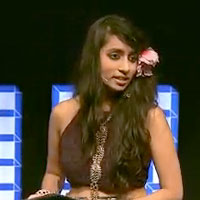
‘Khoya’ is an interactive series for children on the iPad developed by 23-year-old Indian artist, animator and visual artist Shilo Shiv Suleman. The story is written by Avijit Michael who is Shilo’s partner in developing this book. It was released in December 2011 at the INK conference. Before the app’s release, it was showcased at TED Global 2011, the WIRED conference in the UK, the INK conference, and DLD 2012 in Munich and now is available on the App Store for $4.99 or Rs.250
Khoya is a traditional quest tale where player has to guide two children – Maya and Talisma on a journey of discovery and adventure, Find objects, use devices and do a lot more to get immersed in the world of Khoya. It has over 70 pages of artwork and animations, real world quests, immersive interactions that make you a part of the book, magical devices and cartographic interfaces.
AnimationXpress.com’s Parita Upadhyaya spoke to Shilo about Khoya, her role as an artist, challenges, and more…
Excerpts
What is Khoya?
Khoya is an interactive series for children on the iPad that uses New Media to bring alive the magic in a fantasy story. This is not just a book app – it is a gateway to another world. Open it and you’ll find a story that lets you be part of it as the Navigator, you have to guide two children – Maya and Talisma on a journey of discovery and adventure, Find objects, use devices and do a lot more to get immersed in the world of Khoya, Complete real world quests as the characters in the book undertake their own quests, Take photos with the in-app camera and keep a journal of your quest, Rediscover the natural world along with Maya and Talisma.
Linking earth, magic and technology to bring together a breath-taking book with rich illustrations, beautiful animations, fun interactions and an engrossing multisensorial storytelling experience.
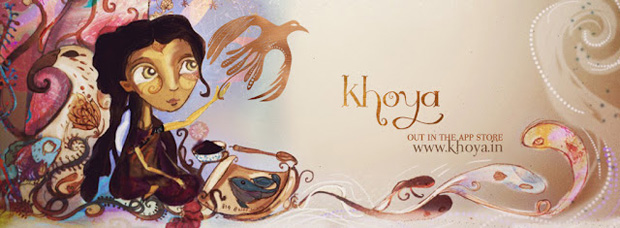
How did Khoya come up?
Khoya began for me as a college project. I was part of a lab called the ‘Toy Lab’ in Srishti School of Art and Design with a Finish Interaction designer: Anders Sandell (now our publisher) as faculty. It was a great lab and like art schools sometimes do, it enabled a lot of us to engage with things that we normally would shy away from. And for me that was technology. My partner Avijit (aka Jugular Bean) and I had been itching to work on something together and Khoya seemed a perfect fit. Me and Avijit met when he was in a rock and roll band many years ago, and we’ve always enjoyed some kind of creative outlet as an extension of our relationship, Strangely enough I was a technophobe studying in a school with thousands of trees but no computers but ended up working on interactive media, and he was an Infosys geek who left all that to work with the environment. And now Khoya brings it all together quite beautifully. We both have a shared passion for mythology, folklore, the Earth and fantasy and this becomes a way for us to channel it. I do all the illustrations and animations, and Avijit does the writing. We both come up with the interactions together jamming it along the way with our developers and publisher. What’s interesting about our process is it sometimes flips the traditional roles of how illustrators and writers work together. Having worked with publishing houses before, I’ve always had scripts handed over to me. Here sometimes I create characters and landscapes and Avijit has to weave a story around it. Or he comes up with a story and I need to create landscapes and characters for it. The story and larger concepts we’ve both created together over brainstorms in little cafes in Goa, off cliff sides in Kodaikanal, and in organic farms in Pondicherry.
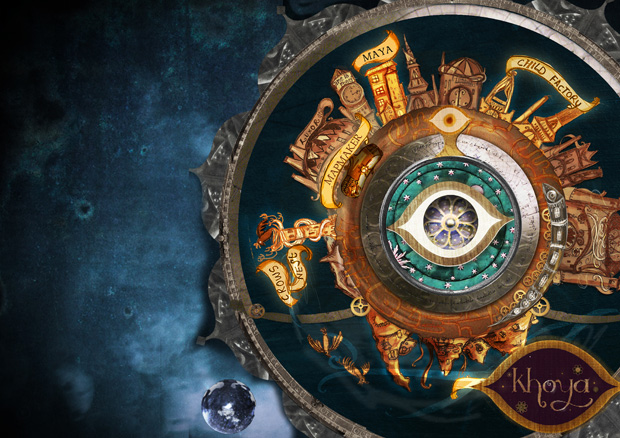
What is the concept of Khoya?
When I was young, my grandfather gave me a silver pocket watch which was a 50 year old piece of technology. And despite it not working it became this gilded gateway into a world full of time travelers and magicians, our mobile phones and cool cameras have stopped us from dreaming the same way. People are so excited about how technology is functional and usable that they forget how technology is also Magical. Sure, it’s useful to be able to fly to London in 10 hours, but the idea that we are actually floating in the clouds, flying around the world is forgotten in that usability. With Khoya we wanted to use technology to create magical experiences for children. I started working on Khoya as an Augmented Reality paper book for kids that used technology to enable and revolutionize storytelling. In its first avatar 2 years ago I did all the writing, animating and illustrating. And it really was quite different from Khoya in its current incarnation, then when the iPad came out it really excited us all. What we saw is a storytelling device that was mobile like a book one would curl up under a tree and read, but also capable of knowing where we are, how we hold it, connecting readers all over the world at the same time. It was also an accessible touch screen device.
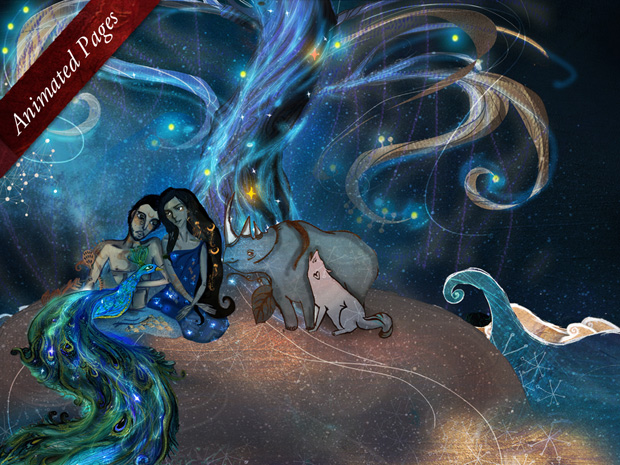
When did you know you wanted to be an illustrator? How did you begin?
Though as a child I was always allowed to paint on walls or whatever surface I could find, Art really came into our lives when I was 12. My mother, Nilofer Suleman decided to study Cartography and so as a child I’d spend hours watching her pouring over those maps creating rivers and mountains with her fingers and each delicately ink spelt name would become a gateway into a world full of pirates and shipwrecks and images that lurked and still lurk in my imagination. We’ve had parallel journeys through art, which has been very special too. She moved away from her maps and detailed miniature paintings when we both joined the Valley School, her to teach and me to learn. And under those tall trees we both began to paint large canvases, broad strokes and vibrant colours. When I started painting then, I would spill ink bottle after ink bottle on paper and watched as it snaked and morphed into images without my mind directing it. Sometimes scribbling out illegible words in notebooks, other times becoming teeth and eyes that would stare out at me in tall forests of bamboo. I illustrated my first book of Hindi poems at 16 when my mother’s friend saw the work I was doing. I knew by then that I wanted to see art in its application, I became a poet, a photographer, I wanted to see art escape the limitations of a canvas and enter the streets, be scribbled in notebooks, and paint their way into lives of children. An amazing thing about being a child is that I would spend hours with my friends creating these invisible worlds that somehow we could both see. Invisible kingdoms built of ether and imaginations those two completely unique individuals could both somehow see! I didn’t want to stop sharing those worlds and so I started illustrating books for children.
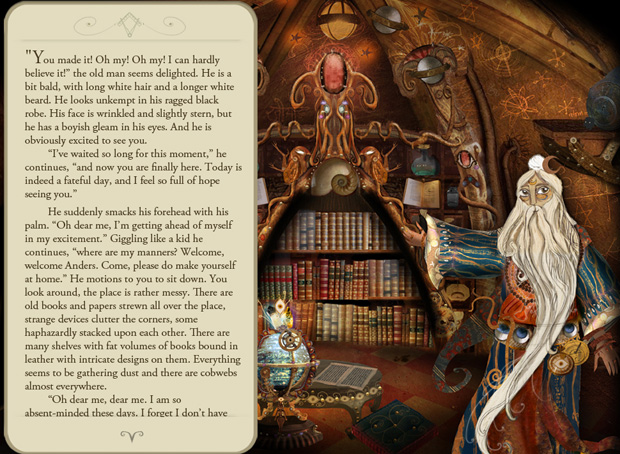
Khoya is a seamless experience across book and apps using latest technology to convey an artistic story. As an artist did you find adapting to the technology difficult?
Adapting to the technology happened quite naturally actually. The process involved a lot of dreaming; learning and seeing magic happen and was quite amazing. Even though it was my first time attempting interaction design, I think that worked to my advantage. It meant creating a User Interface for Khoya with no preconceived knowledge on how a user interface should work by web2.0 rules. It made me a lot more open to experimentation and allowed me to seek a lot of inspiration from older ‘User Interfaces’ like compasses, old dials, astrolabes and other mystical devices. Once I got over my fear/resistance to new technology a lot of things worked out beautifully. We were also lucky to have an amazing crew working on the Coding. A group called Inkoniq based out of Bangalore that were excited by the possibility of doing something both different from the usual functional apps they got but also Indian. Having them do the development was amazing because whatever interactions I could dream up- they were open to jumping in and trying out!
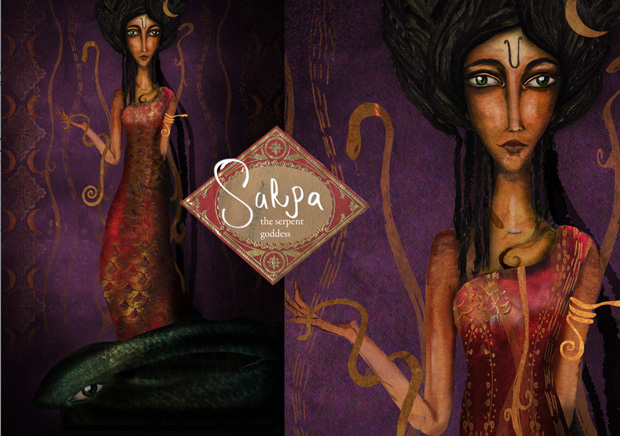
As an artist, what is your creative process, what comes first in your mind — a story, the characters, the environments? Describe your process of creating art?
Interestingly enough a lot of the time the characters came first, the drawings would manifest themselves and then the writing by Avijit would follow. Sometimes it worked the other way around as well. For me I always see characters first, I think without strong characters a story can’t exist. It begins with loads of concept sketches, lots of sleepless nights and always being open to inspiration. Inspiration is everywhere. Colour pallets, the way someone walks or laughs. Inspiration is also open and waiting for you to find it in the form of symbols and archetypes in our myths. Channeling all that to create compelling characters is key! At 23 years old, I find myself travelling a lot and a lot of the inspiration also comes from travel. For example, the Valley of flowers in Himachal is the landscape that our apsaras in Khoya inhabit because of legends that you’ll be abducted by apsaras amongst those flowers if you wander too far. In book 3, in the mountains there are Babas and Yoginis that wander the terrain. Inspired by the rocks of Hampi- we have characters called the “atoot” (unbreakable in Hindi) that are rock creatures. The crows that hang around cawing at us everyday are part of the story too, traditionally in mythology crows symbolize Death, thought and memory and in Khoya they are the gatekeepers between worlds: Khayal, Maut and Yaad.Inspiration IS everywhere, and I think letting yourself get silly and imagine brings them to me. In terms of the artistic process- concept sketching, sometimes making an mseal model of the character and finally doing the final drawings is usually the flow. It takes me between an hour to 2 weeks per illustration, based on how the inspiration flows.
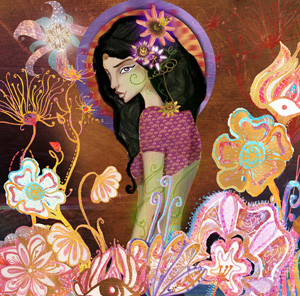
How many artists worked on the Khoya and how long it took them to complete the app?
There was one artist working on the app: Me. I did all the artwork and animation work over 4 sleepless months. I’m a 23 year old illustrator and Artist, and illustrated my first book for kids when I was 16, and I’ve illustrated 8 or 9 others since. I was drawn towards illustration because for me it became a way of keeping myself childlike, which I think is very important for keeping one’s imagination buzzing and being open and receptive to the wonders of the universe. Interestingly enough, a lot of times in the process of our ‘story making’ the artwork came first. When I started looking at creating an ipad app, before there was ever any text all the interactions and the illustrations had been designed. Which I think is quite different from how a book is traditionally worked on. Each painting takes between 4 days to a week and involves weeks of concept sketching, references, mood boards and study. I say ‘study’ because creating Khoya for me has meant months of reading about symbols, myths and understanding what goes into creating characters that not only look like an archetype but also embody some of its symbolic history. For example, with a character ‘Sarpa’ in the next book, who is a snake goddess, it meant weeks of reading about connections between serpents and women through mythology, starting with Eve and Lilith and ending up with Manasa and the Nagas in India. It also meant finding colours that have traditionally been associated with some of these character traits. Or with the compass, it meant looking at astrolabes, compasses, maps, cartographic tools, navigational tools and circular tablets and mandalas and bringing them all together into our map. A big part of the idea is also to bring the Indian version of world archetypes into the global vocabulary. We all know about fairies and nymphs from Greece but very few outside of India know of their counterparts- the apsaras. Or we’ve all seen the archetype of the hermit come alive in Dumbledore and Gandalf, and even the wise old Japanese man, but isn’t this archetype also living in Vyaasa, in new-agers like sadhguru and osho? In all the babas sprinkled in trains and hills and river sides in India? Our characters bring a touch of that Indianness as well the story is written by Avijit Michael who is my partner in developing this book. The Editing was done by our publisher Tank and Bear. And the Code by 3 developers at a group called Inkoniq that do Ipad and Iphone development. And the INK conference is supporting the project and bringing it to the world. Though the idea has been brewing for a few years, the production time was 4 months.
Why you chose to make Khoya for I pad? Are you planning to launch it on any other platform?
What I find fascinating about the ipad and tablets in general is that for the first time in the history of human storytelling, touch becomes an active component in storytelling. We’ve seen human storytelling evolve from plain image to image and text and now in the last hundred years image, text, animation, time, sound, movement and now touch all come together to make storytelling more and more multisensorial. I think what’s really strong about the tablet platform for storytelling, is that the book can know where we are, know how we are holding it, and ask us to participate in the story, and potentially connect readers all over the world at the same time. It can become a magic mirror in we can now alter and overlay new realities upon.
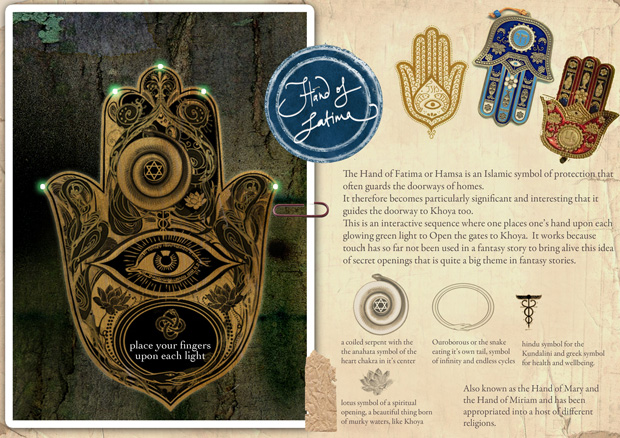
Are you only focusing on children story telling or are you planning to expand your genre?
The target audience is 10+ interestingly enough, in my first phase of creating Khoya; I actually worked with children between 8-12 to write the base of the story. A lot of the research from that period has also helped in the Interaction design because it meant identifying ‘magical ideas’ *like fireflies in a jar that somehow we all had as kids. I think the storytelling I focus on is for all those who have retained the child in them, and good fantasy books do that. Lord of the Rings has a way of transcending age and with Khoya we hope to do the same.
Where have you studied design?
I studied design at Srishti school of Art Design and Technology in Bangalore where I was an animation student. Though I did most of my animation work as an independent study student and I taught myself illustration and after effects. It was in Srishti that Khoya first started off in a lab called the Srishti Toy Lab where students worked on Toys and Media for children. The faculty of that Lab Anders Sandell became a guide through the Khoya journey and now is editor and publisher of the book! Another big source of learning has been my mother Nilofer Suleman who’s a fine artist and paints large colourful canvases full of Indian Kitsch and Street Art. I started painting under her influence when I was 11 or 12 and needless to say I was always allowed to draw on my walls. She never believed in teaching the technicalities but always encouraged relentless creativity and I think that approach to learning really pays off.
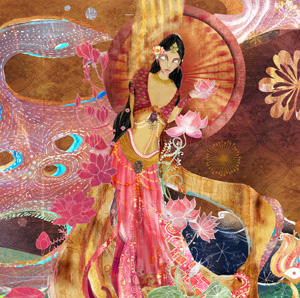 What’s the best part about what you do?
What’s the best part about what you do?
The Love. There’s something very beautiful about being able to make a living and be successful by doing what you love. And it’s the Love that drives everything. While working on fantasy narratives a lot of channeling starts to happen, one is digging deep into universal archetypes, realms of gods and myths. And a lot of larger life lessons are learnt in the silent space between my brush and paper. Each painting takes between 4 days to a week and involves weeks of concept sketching, references, moldboards and study. I say ‘study’ because creating Khoya for me has meant months of reading about symbols, myths and understanding what goes into creating characters that not only look like an archetype but also embody some of its symbolic history.
What are you working on next? What can we expect from Khoya 2? And what would be your dream project to work on?
Right now I really see myself expanding outwards, lots of possibilities round the corner. Painting walls around the world, working on New Media Storytelling labs with some of the most cutting edge technology, helping build and set up a small organic farm in Kodaikanal with Avijit, Travelling and working with Sufi’s in Kutch and Sindh, and continuing my doodling on buses and trains in dusty villages in India. And then there’s Khoya, since Khoya is a series, as technology evolves: so does each book, and that’s pretty exciting to me as well. The second book gets SUPER exciting for us actually because that’s when the real fantasy begins; it’s full of earth and sustainability and awesome interactions and more and more and more. All in all: More travel, more technology made magic, more community art and More Love. Right now I’m just dealing with the wave of possibilities after my talk going out on ted.com, it’s been immense with over 4 lakh views world over and some amazing responses.
While working on a stage design, teaching kids, and doing a few more books (I need more hands) Khoya is my dream project at the moment 🙂 But more dreams will come. Mine is a job of dreaming.
